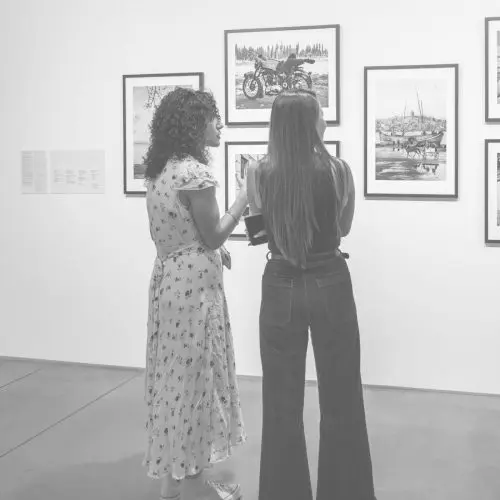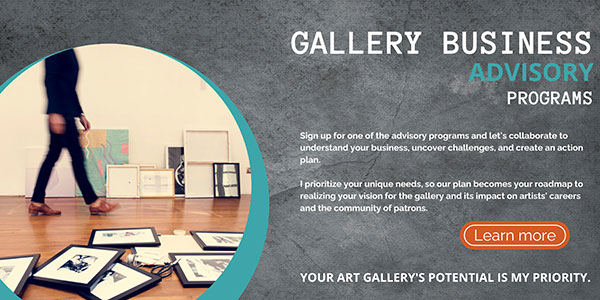In uncertain times, operating your art gallery business can feel like walking a tightrope. As sales plummet to new lows, it’s natural to feel lost and a little helpless. I’m here to tell you that, yes, many things will be out of your control. Still, there are also several opportunities to adjust your art gallery’s business development strategies to bounce back even stronger than before.
Between nurturing artist relationships, managing day-to-day logistics, and keeping collectors engaged, even the most visionary gallerists, like you, can find themselves slowed by economic headwinds. In this climate, every decision you make carries extra weight, making it essential to shift from reactive survival mode to intentional, future-focused planning.
In this article, we will explore art gallery business development strategies to help you thrive during economic challenges. Our focus will be on relationship-driven sales, adaptive management, evolving the sales experience, meaningful marketing, and fostering resilience through reinvention. We will identify key areas where you can concentrate your efforts to not only withstand a downturn but also grow through it. That sounds good!
This moment demands more than endurance—it calls for reinvention. If you’re willing to reimagine your business development strategies, this period of uncertainty can also be one of opportunity: to strengthen your infrastructure, deepen client relationships, and creatively market your artists in ways that build long-term resilience.
Relationship-Driven Sales: Turning Buyers Into Believers
When sales slow, meaningful relationships become the currency of longevity. For your gallery, this means turning one-time buyers into long-term supporters through a blend of personalization, education, and ongoing dialogue. A collector who feels seen, understood, and valued is more likely to return—even in a tighter market.
supporters through a blend of personalization, education, and ongoing dialogue. A collector who feels seen, understood, and valued is more likely to return—even in a tighter market.
Personal touches, such as sending a curated preview before an opening or checking in months after a purchase with a thoughtful update about the artist, signal that you see the collector as more than just a transaction. These gestures, when paired with data from CRM tools that track preferences and engagement, help you craft outreach that is intuitive, relevant, and never generic.
You can also benefit by shifting from a sales-first approach to a service mindset. Rather than pushing artwork during quiet periods, use content to stay connected—offering insights into trends, behind-the-scenes stories, or even lifestyle ideas that reflect your gallery’s unique voice and your clients’ motivations to buy. In the background, a thoughtful educational program—perhaps a short digital guide on collecting or a Q&A series with experienced buyers—can help you cultivate newer collectors and position your gallery as a trusted guide, not just a dealer.
Evolving the Exhibition Sales Experience with Emotion and Accessibility
The art sales process is no longer limited to the opening night reception. Today’s collectors seek a deeper connection to the work and the artist—a journey that blends emotion with accessibility, both in-person and online.
You can enrich the exhibition experience through artist talks, themed events, or storytelling elements that add meaningful context and enhance value for your fans and followers. Nobody wants to feel like they are being run through a sales funnel. Likewise, pricing transparency has emerged as a trust-building strategy. Clear, accessible buying information—whether displayed in your gallery or through an online experience—can eliminate hesitation and increase sales opportunities.
As collector profiles diversify, so too should your approach. Newer buyers may benefit from beginner-friendly resources, while more seasoned patrons may appreciate insight into market trends or curatorial philosophies. Offering lower-priced editions, smaller-scale works, or bespoke commissions also makes your program more inclusive without compromising your gallery’s brand integrity. These micro-collecting opportunities can keep collectors engaged, support artist income, and help bridge financial gaps in quieter periods.
Finally, technology enables exclusivity and service at scale. Private digital viewing rooms, personalized recommendations, and invitation-only online events allow you to recreate the intimacy of the gallery experience for your clients wherever they are. The more supporting events and resources you provide, the more accessible the art becomes, allowing you to connect with prospective buyers on an emotional level. To achieve this, consider reducing the number of annual exhibitions and extending their duration. Additionally, incorporating online-only exhibitions can provide more exposure for artists.
Adaptive Art Gallery Management and Purpose-Driven Operation
Often, when the economy takes a nosedive and collectors get nervous about spending, you have to wait it out. However, this can also be an opportunity to focus on areas of your operations that require improvement in efficiency. This is more difficult to do when sales are high.
Behind every exhibition in your gallery is the less glamorous, but equally vital, machinery of management. And in lean times, the quality of your internal infrastructure can make or break your business. Now is the time to assess your systems, reinforce your mission, and create operational agility.
Start by revisiting your gallery’s purpose—not the tagline on your homepage, but the real reason your gallery exists! When clearly articulated and authentically expressed, your mission can guide not only curatorial choices but also marketing, partnerships, and staffing decisions. Transparency in the gallery sector goes beyond publishing your prices. It’s also about what you stand for—and how you serve artists and art collectors—builds credibility and trust. And that can boost sales.
If hiring feels out of reach for your small team, scaling back doesn’t have to mean sacrificing momentum. Strategic outsourcing to freelance professionals can help you address immediate needs with greater flexibility. This allows you to stay nimble, bringing in specialized skills without committing to long-term overhead.
Meaningful Marketing Through Storytelling, Collaboration, and Digital Focus
In a challenging economy, effective marketing is less about volume and more about meaning. People may pause their buying, but they don’t stop seeking beauty or human connection. The galleries that rise above the noise are those that continue to offer inspiration and access through thoughtful, authentic storytelling.
Hybrid exhibitions that merge in-person programming with digital extensions—like livestreams, interactive catalogs, or virtual studio visits—can expand your reach while strengthening your collector base.
Encourage your artists to be visible, too. When they share personal stories and artistic process insights, they become ambassadors of both their work and your gallery. That kind of authenticity builds trust faster than any ad campaign. For any artists on your roster that might be intimidated by this, you might offer templates or guidelines to help them communicate their stories.
Don’t overlook the power of long-form content. Well-written blog posts on curatorial themes, artist philosophies, or collecting tips can position your gallery as a thought leader and resource—not just a showroom. Pair this with targeted, geo-specific digital advertising to attract art-aware audiences in your region or during gallery events and art fairs.
Lastly, think beyond your own walls. Partnerships with local brands, nonprofits, or peer galleries can open new markets and share marketing resources. If things are slow for you right now, they likely are for them as well. This is a great opportunity to think outside the box and collaborate in unexpected ways to gain attention, new audiences, and present art in fresh ways. Joint events, pop-ups, or shared booths at fairs can also reduce costs and increase exposure—a smart, creative response to economic pressure.
To the Point
A challenging economy doesn’t necessarily require you to scale back your regular business growth initiatives. For your gallery, it can be a period of necessary reinvention—a chance to tighten operations, deepen impact, and reconnect with the values that brought you into this work in the first place. You can turn it around!
By prioritizing relationships over transactions, clarity over volume, and creativity over convention, your gallery can emerge not just stable, but stronger. Art gallery business development strategies that reflect your gallery’s unique mission and values can help you maximize your sales in a challenging economic environment. Art is not a luxury—it’s a cultural and emotional necessity. Right!?!?! When your gallery reflects that truth in how it shows, sells, and speaks, you don’t just stay in business. You lead the way forward.



Leave a Reply